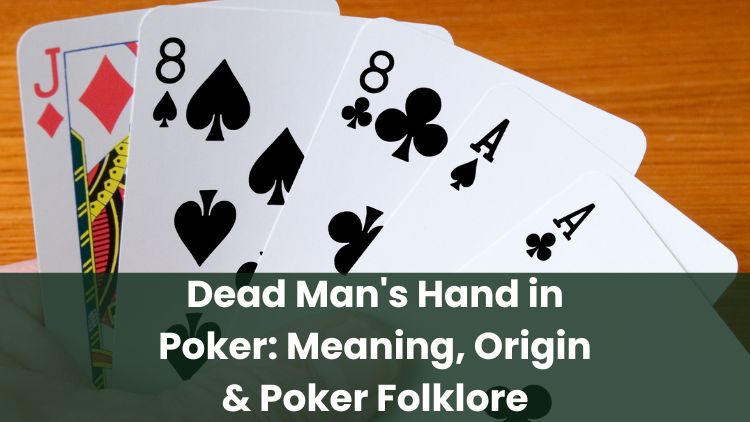
When exploring the world of poker, you may encounter terms that carry a story or historical significance. One phrase that stands out is the “Dead Man’s Hand”. This name often draws curiosity, particularly for people new to card games or gambling.
Many look to discover why this hand is remembered, how the story began, and why it has become part of poker’s cultural history. Whether you are interested in poker legends, curious about UK rules, or simply want to understand more about the game, the Dead Man’s Hand provides an example of how folklore can influence poker terminology. Read on to learn more.
What Is the Dead Man's Hand in Poker?
The Dead Man’s Hand is a particular combination of playing cards in poker. It includes two black aces and two black eights. The fifth card is not definitively recorded, and different accounts list different possibilities. All cards come from a standard 52-card deck.
The Dead Man’s Hand does not form part of official hand rankings. In most poker games, hand values are determined by combinations such as pairs, three of a kind, straights, and flushes. Named hands like the Dead Man’s Hand are folklore and do not alter standard rules.
If you encounter this term online or in a UK casino, it may appear in glossaries or themed games.
Where Did the Dead Man's Hand Come From?
The story originates from poker in the American Old West and is commonly associated with Wild Bill Hickok, a gambler and lawman. According to popular accounts, he held two black aces and two black eights when he was shot while playing poker. Over time, that combination gained a reputation and the name Dead Man’s Hand.
Details vary in historical records. Early newspaper reports do not consistently describe the cards he held, and later retellings solidified the version with two black aces and two black eights. Books, films, and other media helped maintain its recognition.
The Story of Wild Bill Hickok and the Dead Man's Hand
Wild Bill Hickok was known for his card-playing skills and work as a lawman. On 2 August 1876, he was shot at Nuttal & Mann’s Saloon in Deadwood, South Dakota, while playing poker.
Contemporary accounts of the event do not fully agree on his hand. Later accounts describe two black aces and two black eights as part of his hand, which became the version commonly referenced. This story has appeared in books, films, and documentaries, giving it a place in poker folklore beyond the United States. In the UK, it is usually shared as historical context rather than as a factor in gameplay.
What Cards Make Up the Dead Man's Hand?
The Dead Man’s Hand consists of two black aces and two black eights. Typically, this refers to the ace of spades, ace of clubs, eight of spades, and eight of clubs. The fifth card varies according to different accounts.
In standard five-card poker, this hand is scored as two pairs. It ranks above a single pair but below three of a kind, a straight, or a flush. The name appears in glossaries, themed games, and trivia, but it does not change official hand rankings.
Why Is the Dead Man's Hand Linked to Misfortune?
The reputation of the Dead Man’s Hand stems from its historical association with Hickok’s death, rather than the cards themselves. Writers and filmmakers often used this hand to symbolise a pivotal moment or a difficult outcome.
In practical play, outcomes are determined by the rules of the game and the shuffle of the deck. The Dead Man’s Hand is notable for its story, rather than any effect at the table.
How Has the Dead Man's Hand Become Part of Poker Folklore?
The Dead Man’s Hand became part of poker folklore through repeated retellings in media and literature. Authors, historians, and filmmakers used it as a reference to the Old West, which helped maintain its visibility.
Conversations at tables and online discussions further contributed to its cultural presence. Players often share historical anecdotes, and named hands make stories easier to remember. In the UK, references to the Dead Man’s Hand appear in articles, documentaries, and educational materials, providing context without affecting the rules of play.
Dead Man's Hand in Modern Poker Culture
The Dead Man’s Hand continues to be referenced in modern poker culture. It appears in guides, documentaries, and discussions where people examine historical details or cite examples from media.
On UK-facing sites, it may appear in glossaries, themed games, or promotions. It can also be mentioned in trivia or as a descriptive term for a cautious approach to play. In tournaments and cash games, it is scored as two pairs, following standard hand rankings.
For many, the appeal lies in its historical significance. The Dead Man’s Hand connects a familiar ranking with a story that has circulated for more than a century, adding historical context without altering gameplay.
**The information provided in this blog is intended for educational purposes and should not be construed as betting advice or a guarantee of success. Always gamble responsibly.
*All values (Bet Levels, Maximum Wins etc.) mentioned in relation to these games are subject to change at any time. Game features mentioned may not be available in some jurisdictions.
